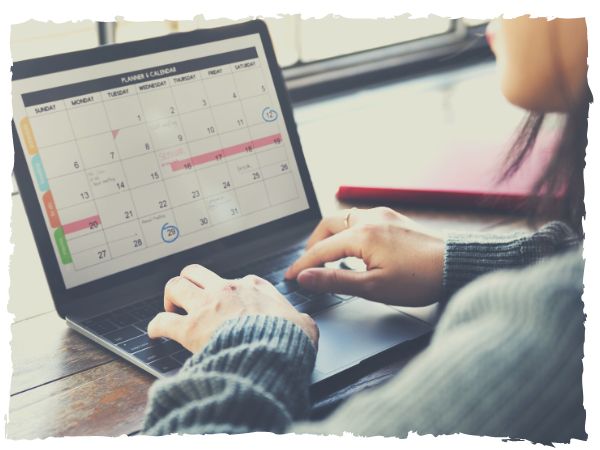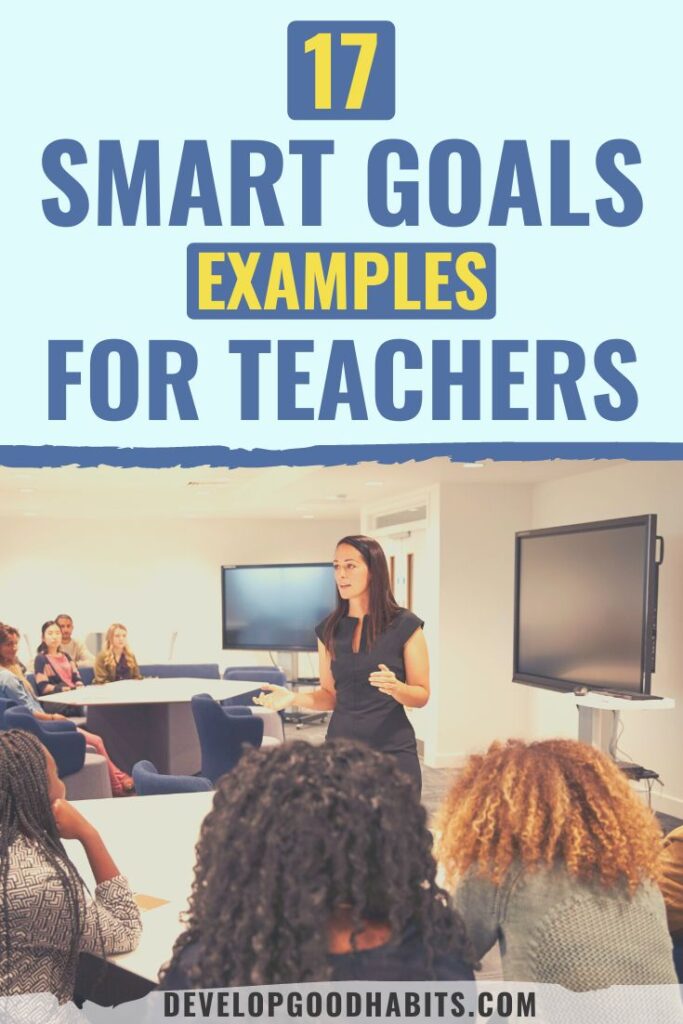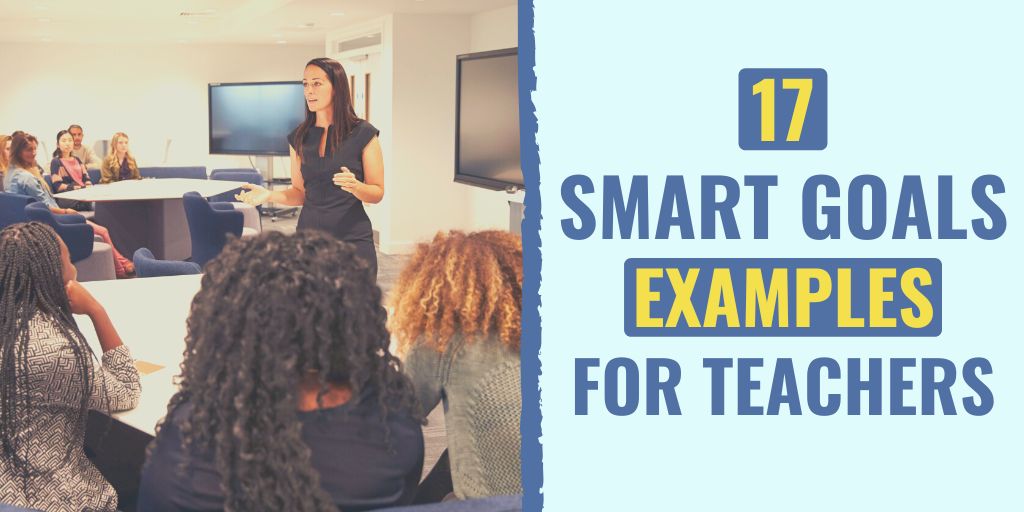There might be affiliate links on this page, which means we get a small commission of anything you buy. As an Amazon Associate we earn from qualifying purchases. Please do your own research before making any online purchase.
In March of 2020, the world flipped upside down when the novel coronavirus outbreak turned into the Covid-19 pandemic.
Schools closed, thereby requiring their students to begin distance learning. Some teachers lost their footing, as well as the sight of their goals. What could they do to achieve the goals they had for their students, and even themselves, if classrooms were empty and schools were vacant?
No matter the future’s uncertainty about students and teachers returning to school, it’s important to focus on being positive. Specifically, you should create goals for short-term future.
So with that in mind, here is a list of 17 SMART goal examples for teachers for this school year and beyond.
What are SMART Goals?
To set proper teaching goals, the goals must be “SMART.” But what does that mean?
SMART goals are well-thought-out and planned objectives that have a high chance of success.
SMART is a framework acronym that describes how you should set your goals and what your goals should involve. There are three distinct types of SMART goals: short-term, long-term, and lifetime goals.
Set short-term goals for the next three months; long-term goals for your future; and lifetime goals, which are just like long-term goals, but progress in a continuous manner as they are your primary life goals.
SMART goals should meet the following criteria:
S: Specific
M: Measurable
A: Achievable
R: Relevant
T: Time-bound
Specific
When it comes to specific goals, they need to be clear and understandable.
Measurable
Establish concrete criteria for measuring progress toward achieving each goal you set up.
Attainable/Achievable
When you name your most important goals, you figure out ways to make them happen. You develop the attitudes, skills, talents, and financial ability to achieve them. Goals that seem out of reach come closer and become attainable—not because they get smaller, but because you improve and grow to reach them.
Relevant/Realistic
Realistic and relevant goals must stand for an aim toward which you are both willing and able to work. If you genuinely believe that you can achieve your goal, it is realistic.
Time-bound/Tangible
Every goal should have a timeframe, or there is no sense of urgency. “Someday” will not work to achieve your goals. Your goal is tangible when it is specific and measurable, and thereby attainable.
Why is it Important for Teachers to Set SMART Goals?
Many teachers have an idea of what they want in the next school year to look like, but many do not. According to educational research, educators who establish goals notice a significant improvement in their classrooms and their self-perception.
Teachers who have goals for improving their teaching skills have a far greater interest in their career and more positive teaching self-esteem.
Surveys show that teachers who set goals for themselves feel like they improved as teachers by the end of the school year.
But what else can setting goals do for teachers?
Setting SMART goals can help teachers:
17 SMART Goals Examples for Teachers in 2024
Teaching goals fall into one of four classifications: enhancing classroom organization, optimizing class time, increasing student engagement, and reinforcing student discussion.
Here is a list of 17 SMART goal examples for teachers:
1. Read a Classic Novel
“By [date], the first day of school, I will start reading a 400-page classic novel with my students to get them interested in reading, and to expand their vocabulary and their appreciation for books.”
S: The goal is specific and to the point.
M: The school year is typically from September to June, so it would be best to have your students finish the book in April, which gives them 7.5 months to read four hundred pages in their entirety or approximately 14 pages a week/2 pages per day. That is achievable.
A: As you have control over your words and your temper, this is an achievable goal.
R: Having your students read a book will help you get closer to the goal of giving them an appreciation of reading and an expanded vocabulary.
T: This goal has a beginning date and a daily/weekly progression period.
Reading is one of the most important things people can do—especially students. Make sure to educate your students about this importance, which will motive them and help them to feel invited to read instead of causing them to despise the concept of learning and books.
2. Begin a Fundraiser
“By [date], I want my classes to begin a fundraiser to raise $500 throughout the school year for a local charity of their choice.”
S: You state that you want your students to raise money via a fundraiser throughout the school year for a local charity of their choice—you have answered the 5 Ws—who, what, where, when, and why.
M: Each time a student raises money and adds it to the total, you are getting closer to $500.
A: This goal is attainable and achievable.
R: This goal helps students understand others’ misfortunes and raises their awareness of those who struggle, thereby learning about the real world and not just the information found in books.
T: The start date is [date], and the end date is the last day of school—the entire school year.
Students do not need to follow in your footsteps but should mimic your attitude and passion. This mimicking will inspire your students to persevere and have hope despite spirit-breaking impediments that may come their way. Inspire them to take on challenges.
You are the role model for overcoming challenges and failures, thereby showing them the values and traits they need to have in all their future pursuits. Teach your students how to think and not just remember information for a test.
3. Understand my Students Better
“By [date], I will start to learn from my students each school year by actively listening, asking questions, and considering their point of view to enhance my understanding of my students.”

S: You have clearly said your aims and why you want to reach them.
M: Each time you discuss something with a student is one unit that measures your pursuit of this goal.
A: You can achieve this goal by initiating conversations with your students.
R: This goal is relevant and realistic as it pertains to enhancing your abilities as a teacher.
T: You have set up a beginning date to begin executing your goal achievement for each school year.
There is so much that teachers can learn from their students. If you notice that one of your teaching practices is not going so well, ask a colleague what they have done or watch a YouTube video to learn.
With Covid-19 around, things are changing all the time, and learning means adapting to implemented changes during the next school year—which are not to hamper you down but to help you grow rather than remain stagnant.
With the different personalities surrounding you every day, your understanding of life widens.
4. Organize My Files
“By [date], I will have arranged my files and thrown out old materials to get organized.”
S: This goal says what you want to achieve and why you want to achieve it.
M: This goal is measurable by figuring out if you have achieved your goal by the date you set.
A: You can achieve this goal by working a little bit at a time towards your set date, thereby making it an attainable objective.
R: It is essential to stay organized as a teacher to give your students the best education.
T: You establish the set date to give your goal a deadline and timeframe.
If you think of yourself as a short-tempered person, you may find this goal challenging. Remember to keep your reputation as a professional by refraining from profanities and obscenities. Students have a great deal to learn, and they need your patience.
You have a massive role in a student’s psychological development and hope for the future. Make sure to develop creative, critical thinking, and problem-solving skills to resolve issues quickly. Try meditation as well.
5. Enroll in an Educational Course
“By [date], I will have signed up for an educational course to enhance my teaching skills as I strive to become better.”
S: This goal precisely specifies what you want to do and why.
M: Your enrollment in the course measures progression towards this goal, as does self-reflection to figure out what you learned and how you will apply the information.
A: As you can only improve yourself, and since you control whether you go to the course or not, this objective is accomplishable.
R: As you are a teacher who wants to become better, an educational course that enhances one’s teaching skills is relevant and realistic.
T: The educational course has established timeframes, and you have a date to sign up for it.
Bettering yourself can only be possible if you want it to be. Strive to give your students the best of yourself, as teaching is one of your most significant contributions to the world’s progression.
6. Avoid Teacher Burnout
“By [date], I will begin to avoid teacher burnout at school by arranging my schedule to build in at least one hour of ‘me’ time every day, doing what I want to do.”

S: This goal answers the 5 W questions—who, what, where, when, and why explicitly.
M: You will recognize your progress by noticing each passing day that you take an hour for yourself.
A: You have the power and the authority to achieve this goal.
R: This goal is relevant to your success as a teacher.
T: The goal is a daily, one-hour period.
Make sure to take time for yourself. It is not an unrealistic, senseless, selfish, or impossible idea. To de-stress and to be an effective teacher, you must take time for yourself. You can start with something small and then aim for something bigger later. You will become happier when you take time for yourself.
7. Give Up Control in the Classroom
“By [date], I will start to give up control in the classroom once every week, and let my students reign, so they have a say in their education.”
S: You have expressly stated this goal with clarity.
M: Determine your goal's progression via students’ improved grades, classroom interaction, and feedback.
A: You are the one who decides who controls your classroom, so this is an achievable objective.
R: As a teacher, this goal is relevant for you to teach, and for the youngsters in your class as students, to learn.
T: You have decided to aim for one day a week to give students control, with a beginning start date of [date].
Some teachers are afraid of giving up their control, but it can benefit you to give your students some control over how they learn. It helps them have self-confidence and pride in their work. It also supplies a sense of purpose and motivation. Give your students a few options.
Side note: If you're looking for bulletin board ideas, here's our roundup of our favorite summer bulletin boards.
8. Reach Out to Parents
“By [date], I will have reached out to a minimum of ten parents by calling or emailing to get them involved with their student and the class.”
S: This goal shows your clearly stated objective.
M: Each parent that responds will count as one unit of measurement, and so you can measure your progress every time a parent comes to school in a 4-week timeframe.
A: You have all the tools you need to achieve this goal.
R: This goal is relevant to the student’s success in class and realistic for a teacher.
T: You have set a date to achieve this goal and a timeframe to measure your progress.
Most teachers want parents involved more, but many teachers have tasks that prevent them from making this happen. But you can invite parents to play an active role in the student’s education.
Encourage parents to volunteer, assign a family project, or extend an invitation to attend classroom events.
9. Make Learning Fun
“By [date], I will begin to make learning fun by substituting weekly worksheets and lectures with games and projects.”
S: You have set a goal with a precise and detailed aim.
M: Every time you see a student’s grade increase and listen to their positive feedback about the class, you will know your plan is working and that you have achieved your goal.
A: By using other means to educate your students, you will still stay on top of your lesson plans and curriculum while watching your students’ grades improve.
R: As students learn more when they have fun, this goal is entirely relevant and realistic.
T: You have a date set that you want to begin your goal, and you want to continue to achieve your goal every week.
Turn worksheets into games and lessons into experiments. Take the classroom outside and give your students options. Learning should be fun every day, so put yourself in your students’ shoes and imagine how that could happen.
10. Manage My Schedule More Effectively
“In the next month, I will overhaul my schedule to be more streamlined and set up in a way I can better track and manage my time.”
S: There is a specified final goal outlined for this target.
M: The measurable factor of this goal is lower stress and fewer conflicts and issues with schedules.
A: Every day, week, and month with less stress and fewer issues with scheduling, the closer you are to reaching the final goal of an effective schedule.
R: This goal is relevant as it can improve work and personal schedules and reduce conflict between the two when it comes to schedule management.
T: The timeline set for the first step of the process has been set to a month and can easily be added and expanded as needed to accommodate additional goals related to this one.
When your schedule as a teacher is streamlined and easy to follow, you will have more time and energy to focus on your students and be better prepared for the daily and weekly tasks ahead of you.

11. Increase Test Scores and Student Performance
“By the end of the semester, my students will see at least a 25% increase in performance scores and grades across all subjects on average.”
S: A specific target has been clearly defined and outlined here.
M: The goal has measurability that helps you stay on target and focused on the goal with a set milestone to reach in the allotted timeframe.
A: This is an attainable goal, and that can be followed step by step as you follow the established plan.
R: Setting a goal like this is relatable as it focuses on metrics and progress within the classroom and helps you and your students get the most out of every day in the class.
T: As far as deadlines go, this is a goal that sets a clear target date or time to reach it.
Goals that focus on improving student performance, retention, and success are always great milestones and serve to keep you and your students on track and continuing to make forward progress.
12. Set Up an In-Class Reading Contest
“Within the next three months, the class will start working on a reading project with reading goals and rewards/motivations set up for each reading level.”
S: The specified goal here is to be ready to launch a new class contest/project focused on reading.
M: Measurable steps will include progress made towards drafting processes, procedures, rules, rewards, and outlining the details of the reading contest.
A: This is an attainable and appropriate goal as it focuses on vital educational goals and aims to make reading more fun for the students.
R: Seeking to combine critical reading skills with a fun learning environment is an important goal for any teacher to strive to maintain in their classroom.
T: Timeline set for this goal states that the contest will be ready to launch within the next three months, giving adequate time to plan and prepare.
Finding ways to motivate students and reward their hard work and accomplishments can be a challenge at times, so being mindful and direct with goals like this is a great approach to take.
13. Encourage Extra-Curricular Activities Among Students
“Month by month, my students will take advantage of the extra-curricular activities available to them through the school.”
S: With the specified destination outlined here, you can stay focused on the end goal.
M: Every month you will be able to measure and compare your progress from one month to the next to see your strengths and weaknesses as you work on promoting these activities in the classroom.
A: The step-by-step process of researching, preparing, and implementing these activities will lay out the attainable goals and milestones you can reach for.
R: Extra-curricular activities are an essential part of education for any child. Working that into the classroom and regular educational program is a goal every teacher can be proud of.
T: The timing for this goal is set to be specific and adaptable to provide long-term and ongoing motivation for the classroom as a whole.
Learning is a never-ending journey, and it takes place outside the walls of the classroom, so encouraging extracurricular activities is something teachers need to be actively doing across the board.
14. Start Up an In-Class Garden
“For next semester, the class will have an indoor mini-garden to use as part of our science and ecology study unit.”
S: The specific target of an in-call garden sets the parameters for this goal.
M: Measurable steps for this goal will be spaced out throughout the semester, comprising things such as research, preparation, construction, trial runs, and the final reveal of the class garden setup.
A: This goal can be attained easily with proper planning and management skills which will further the progress and means used to reach this classroom goal.
R: As a relatable classroom project, this goal will be worth the effort and will be a valuable resource for the class.
T: The time set for achieving this goal is far enough in the future to allow it to be attained while also setting the final achieve-by date of the start of next semester.
Many students learn best by doing something and seeing the process and results, so an in-glass garden can be a wonderful teaching and learning tool to bring book learning to life in a real-world setting.
15. Look Into Getting a Classroom Pet
“Within the next four months, I will have a plan in place to set the class up to welcome a new classroom pet to join us.”
S: The goal outlined here is specific and focuses on the process of getting a class pet for the students.
M: Measurable goals like this have a defined end goal that can be monitored, and progress noted, making it more likely to succeed.
A: The attainable nature of this goal is such that it can be accomplished and is not too lofty that it is impossible or overly complicated for you to accomplish for the class.
R: As far as classroom goals are concerned, this one is relevant because it can help improve the classroom environment and student interactions in the classroom.
T: As far as classroom goals and deadlines go, this is a goal that sets a clear date or time to reach this target.

Responsibility is a skill students need to learn, and taking care of another living thing, under the close supervision of an adult, can be a life-changing learning experience for students of many ages.
16. Incorporate Art and Music Into the Class More Often
“I will prepare special lesson plans for next semester that incorporate music and art into the lessons in an inclusive and fun way.”
S: Specified plans focused on lesson plans, and a specialized guide keeps this goal on track.
M: Measurable steps include planning and integrating art and music into the standard class lessons and activities that the students will be interacting with.
A: This goal is attainable and can be achieved with proper planning and considerations for the inclusion and utilization of classroom tools and resources.
R: The relevancy of this classroom goal remains as more educational programs are working to include arts in lessons and class activities.
T: Timing for this goal is set for the following semester, providing a clear end date and goal to shoot for.
While some schools are cutting programs like art and music, others are looking for a way to work them into classes and lessons and preserve that creative spark that has been shown to help students learn.
17. Start Up a Monthly Parent Newsletter or Email
“By the end of the term, I will have a plan in place to make and send out a monthly newsletter highlighting class activities and interesting topics to send to parents.”
S: Simple and specific goals like this are easy to focus on and play out step by step.
M: Measurable success in this goal is putting out the monthly newsletter.
A: It is an attainable goal that can be broken into steps that can be carried out by the deadline set up.
R: A newsletter to improve communications with parents is a very relevant goal to work towards.
T: The deadline is easy to work with and remember and gives enough time to complete related tasks.
Keeping open lines of communication with parents can be one of the most critical steps a teacher takes and is something that should be a top priority for any teacher.
Final Thoughts on Smart Goals Examples for Teachers
There you have it. SMART goals for teachers should be specific, measurable, attainable/achievable, realistic/relevant, and time-bound/tangible.
Establish your education goals by taking these steps and applying the tips above, and you are on your way to a great school year!
Need more inspiration? Check out our roundup of SMART goal templates to help you create your goals for this school year.
And if you're looking for more examples of SMART goals for educators, check these blog posts:
- 8 SMART Goals Examples for Kindergarten Teachers
- 11 SMART Goals Examples for Special Education Teachers
- 10 SMART Goals Examples for an IEP (Individualized Education Program)
Finally, if you want to take your goal-setting efforts to the next level, check out this FREE printable worksheet and a step-by-step process that will help you set effective SMART goals.


